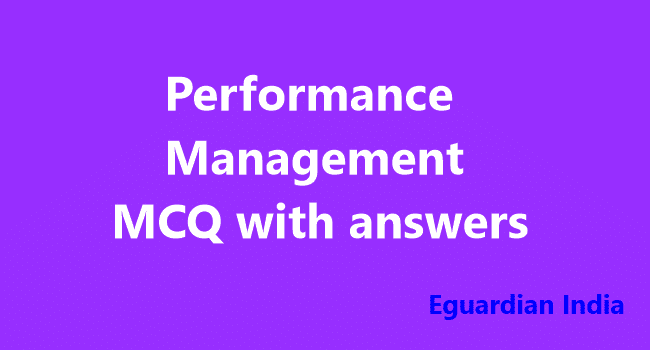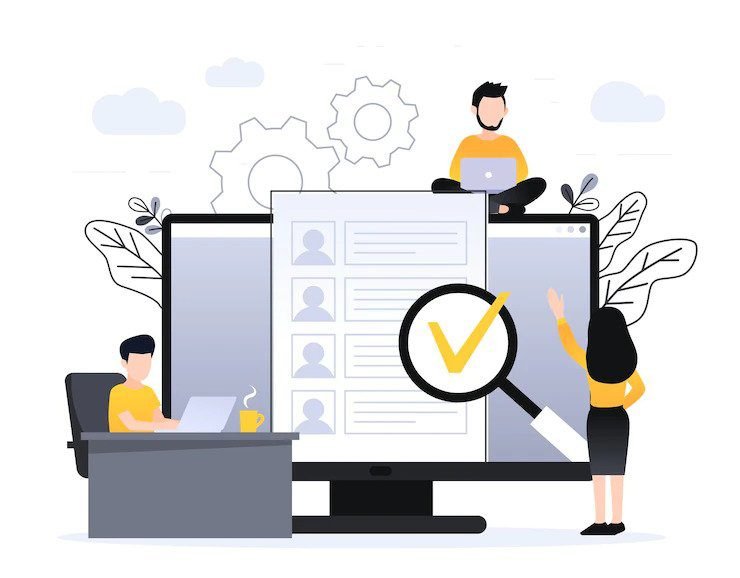Top 70 Performance Management Questions and Answers pdf
Top 70 Performance Management Questions and Answers pdf for 2024 exams!
In the modern corporate landscape, where organizations constantly strive for excellence, performance management has emerged as a crucial aspect of ensuring success. Performance management encompasses a range of practices and strategies to improve employee performance, drive organizational growth, and achieve strategic objectives.
This article delves into the world of Performance Management, exploring its definition, importance, and purpose.
Definition of Performance Management
Performance management is a systematic approach to establishing objectives, evaluating progress, offering feedback, and fostering the competencies and talents of staff members to improve their performance and attain company objectives.
It is not just a once-a-year event but an ongoing and dynamic process involving continuous communication and collaboration between managers and employees.
Importance of Performance Management in Organizations
Performance Management plays a pivotal role in today’s competitive business environment. It is a compass guiding organizations towards efficiency, productivity, and success. By aligning individual employee performance with organizational objectives, Performance Management fosters a culture of accountability and excellence.
Moreover, it provides a platform for recognizing and rewarding top performers, motivating employees, and nurturing talent within the organization.
Purpose of Performance Management
Primary aim of Performance Management is to improve individual and organizational performance by creating a structured and transparent system for evaluating and enhancing employee capabilities.
Through goal setting, performance evaluation, and development planning, Performance Management ensures that employees have the requisite abilities and means to succeed in their positions and contribute to the organization’s overall success.
Benefits of Performance Management
1. Assessing Knowledge and Understanding: One of the critical benefits of Performance Management is its ability to assess employees’ knowledge and understanding of their roles and responsibilities.
By implementing well-designed assessments, organizations can gauge their workforce’s level of expertise and competence. This, in turn, helps in identifying skill gaps and areas that require further training and development.
2. Objective Evaluation of Employee Performance: Performance Management provides a structured framework for objectively evaluating employee performance.
Managers can provide fair and unbiased employee feedback through clear performance metrics and criteria. Objective evaluations ensure transparency and help identify high performers who can be nurtured for leadership roles and areas where improvement is needed.
3. Time-Efficient Assessment Process: Traditional performance evaluations often consume time and effort, leading to resource strain. Performance Management, when implemented effectively, streamlines the assessment process, making it more time-efficient and less burdensome for both managers and employees.
Technology and automated systems can further enhance the efficiency of the process, allowing more time for strategic decision-making.
Types of Performance Management
Performance Management is not a one-size-fits-all approach. Organizations may adopt various methods and models to suit their unique needs and cultures. Some common types of Performance Management include:
1. Traditional Appraisal Systems
Traditional appraisal systems involve annual or periodic evaluations where managers provide feedback on employee performance based on pre-defined criteria. While this approach has been widely used, it may need more agility and address real-time performance issues.
2. Continuous Performance Management
Continuous Performance Management, on the other hand, encourages continuous feedback and coaching sessions between managers and employees. This approach encourages regular check-ins, fostering a culture of continuous improvement and development.
3. 360-Degree Feedback
360-degree feedback is collecting feedback from various sources., including peers, subordinates, external stakeholders, and managers. This holistic approach comprehensively views an employee’s performance and behaviour.
4. Objective and Key Results (OKRs)
OKRs are a goal-setting framework that aligns individual and team objectives with organizational goals. It focuses on setting ambitious and measurable objectives, driving employees to achieve significant outcomes.
Best Practices for Creating Performance Management
To create an effective Performance Management system, organizations can follow these best practices:
1. Clear Goal Setting
It is important to establish goals that are clear, measurable, and in line with the organization’s strategic objectives. When setting goals, making them specific, achievable, relevant, and time-bound is essential. It is commonly known as creating SMART goals.
2. Regular Performance Reviews
Conduct regular performance reviews to provide timely feedback to employees. These reviews should be conducted in a constructive and supportive manner, focusing on strengths and improvement areas.
3. Training and Development
One effective strategy to improve the abilities and expertise of your employees is to invest in training and development programs. A well-trained workforce is more likely to achieve exceptional results.
4. Employee Involvement
Encourage employee involvement in the Performance Management process through self-assessment and goal-setting. It fosters a sense of ownership and accountability.
5. Continuous Improvement
Regularly assess and refine the Performance Management system to adapt to changing organizational needs and industry trends. Continuous improvement ensures the system remains relevant and practical.
performance management questions and answers pdf
Sample MCQs of Performance Management
To reinforce the concepts discussed above, here are some sample MCQ (Multiple Choice Questions) on Performance Management:
1: Knowledge-Based Question
Q. What is the primary purpose of Performance Management?
a) Setting organizational goals
b) Assessing employee knowledge
c) Evaluating employee performance
d) Enhancing employee skills
Answer: c) Evaluating employee performance
2: Scenario-Based Question
Q. An employee consistently meets and exceeds performance targets, demonstrating exceptional skills. What is the most suitable action for the manager to take?
a) Provide constructive feedback for areas of improvement
b) Recognize and reward the employee’s performance
c) Reduce the employee’s workload to prevent burnout
d) Offer additional training to enhance skills further
Answer: b) Recognize and reward the employee’s performance
3: Skill-Based Question
Q. Which Performance Management type emphasizes ongoing feedback and coaching between managers and employees?
a) Traditional Appraisal Systems
b) Continuous Performance Management
c) 360-Degree feedback
d) Objective and Key Results (OKRs)
Answer: b) Continuous Performance Management
Implementing Performance Management in Organizations
Implementing Performance Management requires careful planning and communication. Here are some essential steps to effectively introduce Performance Management in organizations:
1. Assess Organizational Needs: It is essential to comprehend the goals and objectives of the organization and pinpoint the key performance indicators (KPIs) that correspond with these objectives.
2. Communicate with Employees: Transparently communicate the purpose and benefits of Performance Management to employees at all levels. Address any concerns and ensure buy-in from all stakeholders.
3. Train Managers and Employees: Train managers on how to conduct fair and effective performance evaluations. Additionally, train employees on how to set and achieve performance goals.
4. Select Appropriate Tools and Technology: Choose the right tools and technology to support the Performance Management process. Automated systems can streamline data collection and analysis.
5. Establish Feedback Mechanisms: Encourage open and regular feedback between managers and employees. Create a culture that values constructive criticism and fosters a growth mindset.
6. Monitor and Review: Please ensure that you monitor the effectiveness regularly of the Performance Management system and make required adjustments based on feedback and results.
Challenges and Solutions in Performance Management
While Performance Management can offer numerous benefits, organizations may encounter challenges during its implementation. Some common challenges and their solutions include:
Challenge 1: Lack of Employee Engagement
Solution: Involve employees in the goal-setting process and encourage their active participation in the Performance Management process. Solicit feedback and create opportunities for employee input.
Challenge 2: Inadequate Training
Solution: Provide comprehensive training to managers and employees on the Performance Management process, including feedback delivery and goal setting.
Challenge 3: Biases in Evaluations
Solution: Implement a 360-degree feedback system to gather inputs from multiple sources and ensure a more comprehensive evaluation. Offer bias awareness training to reduce potential biases.
Challenge 4: Insufficient Data Analysis
Solution: Use technology-driven data analytics tools to analyze performance data and identify trends, strengths, and areas for improvement.
Challenge 5: Resistance to Change
Solution: Effectively communicate the benefits of Performance Management and how it aligns with individual and organizational growth. Address concerns and be transparent about the reasons for implementing the system.
Top 70 Performance Management Questions and Answers pdf download
1. Performance appraisal can be defined as the systematic evaluation of individuals’ performance on the job and their ___ for ___. (True/False)
Answer: Potential, development
2. PA can be seen from at least ___ different dimensions. (True/False)
Answer: five
3. Since different managers do PA, it needs to give more insight into employees’ contributions. It hence needs to enable categorising employees according to their organisational value. (True/False)
Answer: False
4. PA gives insight into how we create a job description, publicise jobs, and select and induct. (True/False)
Answer: True
5. PA creates a perverse competitive environment, which is often unhealthy. (True/False)
Answer: True
6. Despite the arguments against PA, it is necessary for administrative decisions, eliciting desired behaviour, enabling individual growth and personnel development, incorporating human resource planning with the total human resource system and for ___.
Answer: Fulfilling the legal requirements
7. McGregor (1957), in his classic piece titled “An Uneasy Look at Performance Appraisal”, has identified ___ essential functions/ needs of the performance appraisal.
Answer: Three
8. PA has an evaluative role, communicative role and ___ role.
Answer: Short and long-term developmental
9. Lack of training of ___ can be a significant problem in PA.
Answer: Appraisers
10. Performance appraisal is a data generation system for ___ conceptualisation and implementation.
Answer: Strategy
11. Performance appraisal acts as an ___ device for the human resource system.
Answer: Integrating
12. Filling the ___ form is the starting point of PA.
Answer: Self-appraisal
13. Joint evaluation is the most essential yet hated part of the PA process. (True / False)
Answer: True
14. Rebuttal is essential to meet the ends of ___.
Answer: Justice
15. One of the pitfalls of the HR department in PA is under-training managers in the process. (True/ False)
Answer: True
16. HR departments often tend to believe that ___ based appraisal will serve as protection against challenges by employees.
Answer: Ratings
17. HR departments sometimes tend to play the appraisal ___.
Answer: Cop
18. ___ involves the comparison between two individuals.
Answer: Paired comparison
19. the employees must understand that the manager and they share similar ___ and ___.
Answer: Goals and concerns
20. The PM planning details are always recorded in the document. (True/False)
Answer: True
21. You can segregate the end-cycle PM evaluation and the PM planning though it may lead to a need for more flow. (True/False)
Answer: True
22. In the graphic rating scale, various employees’ performance is given graphically to get an overall picture of the sub-unit or team. (True/False)
Answer: False
23. Critical incidents method describes how the employee demonstrated behaviour. (True/False)
Answer: True
24. Forced distribution method is ideal for small teams and units. (True/False)
Answer: False
25. It is necessary to set objectives before starting project work. (True/False)
Answer: True
26. Fact-finding exercise can be part of ___.
Answer: Assessment centre
27. 360-degree appraisal method involves three levels -employee, supervisor and subordinate. (True/False)
Answer: False
28. Potential appraisal presupposes that performance appraisal is of the past and hence not holistic. (True/False)
Answer: True
29. ___ are measuring scales in which the scale points to definite and indefinite behaviours.
Answer: BARS
30. Customer feedback is an essential component of the performance appraisal of employees. (True/ False)
Answer: False
31. ACR refers to ___.
Answer: Annual confidential report
32. PAR refers to ___.
Answer: Performance appraisal report
33. There are three feedback types: positive, negative and ___.
Answer: Abusive
34. Most organisations have performance feedback once a year, which is considered sufficient. (True/False)
Answer: False
35. Performance appraisals are most effective based on a single evaluator’s feedback. (True/False)
Answer: False
36. A performance appraisal must include specific information about the evaluated individual. (True/False)
Answer: True
37. Formal performance reviews should only have substantially new things discussed earlier. (True/False)
Answer: True
38. Making performance feedback meaningful to the individual and the organisation should be the ultimate objective to improve in this area. (True/False)
Answer: True
39. There are ___ components in good feedback.
Answer: four
40. While giving negative feedback, give the other person an opportunity to ___.
Answer: Respond
41. The person giving feedback should offer ___ suggestions, which the person taking feedback can use.
Answer: Specific
42. The ___ systems provide individuals with feedback from various organisational levels.
Answer: Multisource
43. ___ feedback makes a person singularly responsible for his performance improvement.
Answer: Self-directed
45. If there are fewer than 10 subordinates, a feedback report should not be provided to the supervisor. (True/False)
Answer: False
45. Stakeholders are people who are affected by an individual’s ___.
Answer: Performance
46. Annual assessment allows managing and monitoring of ___.
Answer: Values
47. A 360-degree feedback process is only as effective as the ___ that make up the survey.
Answer: Items
48. People give honest feedback only when there is a ___ in doing so.
Answer: Benefit
49. Peer rating is an excellent indicator of ___ performance.
Answer: Future
50. Peer input can be effectively used for determining ___ and ___.
Answer: Awards, recognition
51. One of the main reasons for the unsuccessful implementation of a 360-degree feedback process is the need for a clear purpose. (True/False)
Answer: True
52. Multi-rater feedback can be a good substitute for managing a poor performer. (True/False)
Answer: False
53. It is unnecessary to involve the key stakeholders in designing and implementing a 360-degree appraisal process. (True/False)
Answer: False
54. Complete communication is of no importance with 360-degree feedback. (True/False)
Answer: False
55. The pillars of a learning organisation are organisation, ___, knowledge and ___.
Answer: People, technology
56. While designing a PM in knowledge organisations, there has to be equal emphasis on individual and ___ performance.
Answer: Team
57. Within the learning organisation, there is an informal organisational structure without formal boundaries, making ___ more complex.
Answer: Performance management
58. There are ___ types of virtual teams.
Answer: Six
59. ___ and ___ are two significant challenges while managing the performance of a virtual team.
Answer: Fairness, equity
60. Virtual teams require a higher degree of ___ trust among their members and leaders.
Answer: Trust
61. The line managers are crucial in implementing performance management because they are___ for the task achievement, and HR is only a facilitator.
Answer: Responsible
62. One of the essential ways to address under-performance is effective ___ between managers and staff.
Answer: Working relationship
63. Line managers shy away from giving poor performance feedback because they fear the employee’s negative feelings may affect ___.
Answer: Production
64. Professor Yasser and Dr Wasi, who were great supporters of performance pay, believed that ___ was the main incentive for increased productivity.
Answer: Money
65. Research evidence suggests that performance pay is adequate only when the work is pure___.
Answer: Mechanical
66. Lower rate of labour always leads to lower labour costs. (True/False)
Answer: False
67. Sub-categories of hygiene factors include 1) working conditions, 2) the level and the quality of supervision, 3) the company policy and administration, 4) interpersonal relations, 5) job security, and 6) salary. (True/False)
Answer: True
68. ‘Expectancy’ means the employee believes the reward is desirable or valued. (True/False)
Answer: False
69. Linking ___ to performance is the most basic way of linking performance to reward.
Answer: Pay band
70. When we say that ‘your salary will increase by one increment if your performance meets expectation and by two increments if it exceeds expectation’, we assume that the employee values this. It can be explained by the term ___.
Answer: Valence
Download Top 70 Performance Management Questions and Answers pdf
Conclusion
The Top 70 Performance Management Questions and answers pdf provided in this article are a valuable resource for anyone preparing for an exam. These questions cover a wide range of topics within performance management and offer detailed explanations for each answer.
By practicing these MCQs, you can enhance your understanding of the subject and improve your chances of success in your exam. We encourage you to share these MCQs on social media so that others can also benefit from this valuable resource.
Remember, preparation is key to achieving excellence, so make the most of these questions and ace your performance management exam!



